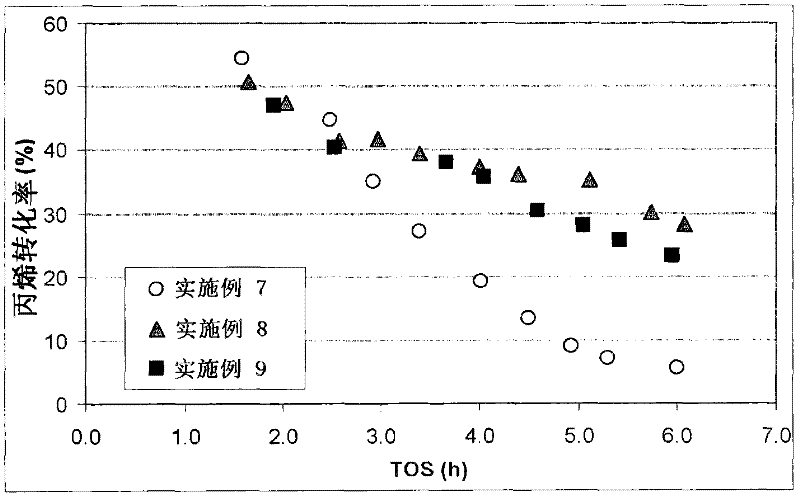Olefin Oligomerization Process
A diesel engine, a range of technology, applied in chemical instruments and methods, processing hydrocarbon oils, hydrocarbon oil processing products, etc., capable of solving problems affecting the relative kinetics of linear and branched chain growth, limiting the degree of branching, etc.
- Summary
- Abstract
- Description
- Claims
- Application Information
AI Technical Summary
Problems solved by technology
Method used
Image
Examples
Embodiment 1
[0050] Na,K-θ-1 zeolite (Si / Al=25, Na / Al=0.15, K / Al=0.70, and crystal size 200 nm) was treated with NH using the following procedure 4 Cl is exchanged to obtain the hydrogen form: 3 g of zeolite in 80 ml of NH 4 Cl aqueous solution (4.03g NH 4 Cl), at 353K, stirred at reflux for 2 hours. Then, the obtained slurry was filtered, washed and dried at 373K for 12h. Finally it was calcined at 773K for 3 hours.
Embodiment 2
[0052] Zeolite θ-1 in its hydrogen form (Si / Al=50, and rod-shaped crystallites of 200×800 nm) was treated with 0.016M NaNO 3 The solution was exchanged at 353K for 15 hours at reflux with vigorous stirring, using a solution / solid weight ratio of 10. The solid was then isolated by filtration, washed with distilled water and dried overnight at 373K. Finally, the partially exchanged sample was calcined at 773 K for 3 h. The sample prepared in this way had 10 mol % of aluminum (ion exchange sites) which was neutralized by Na (Na / Al=0.10).
Embodiment 3
[0054] Zeolite θ-1 in its hydrogen form (Si / Al=50, and rod-shaped crystallites of 200×800 nm) was treated with 0.008M KNO 3 The solution was exchanged at 353K for 15 hours at reflux with vigorous stirring, using a solution / solid weight ratio of 10. The solid was then isolated by filtration, washed with distilled water and dried overnight at 373K. Finally, the partially exchanged sample was calcined at 773 K for 3 h. The sample prepared in this way had 17 mol% of its aluminum neutralized by K (K / Al=0.17).
PUM
 Login to View More
Login to View More Abstract
Description
Claims
Application Information
 Login to View More
Login to View More - Generate Ideas
- Intellectual Property
- Life Sciences
- Materials
- Tech Scout
- Unparalleled Data Quality
- Higher Quality Content
- 60% Fewer Hallucinations
Browse by: Latest US Patents, China's latest patents, Technical Efficacy Thesaurus, Application Domain, Technology Topic, Popular Technical Reports.
© 2025 PatSnap. All rights reserved.Legal|Privacy policy|Modern Slavery Act Transparency Statement|Sitemap|About US| Contact US: help@patsnap.com



